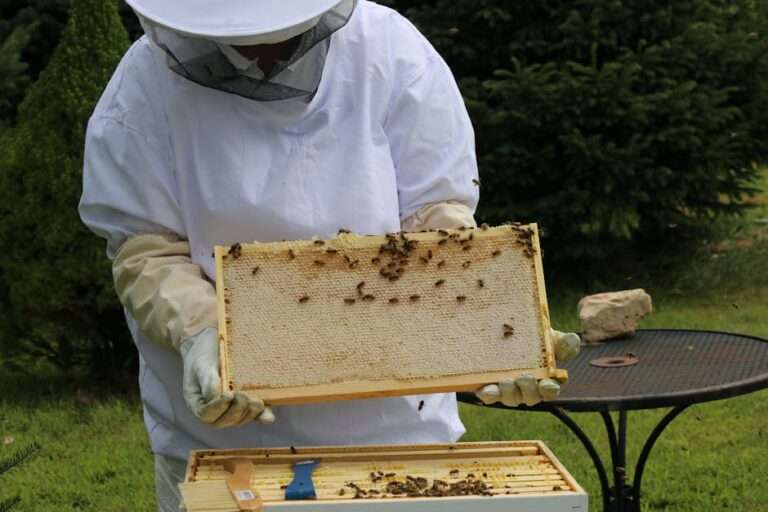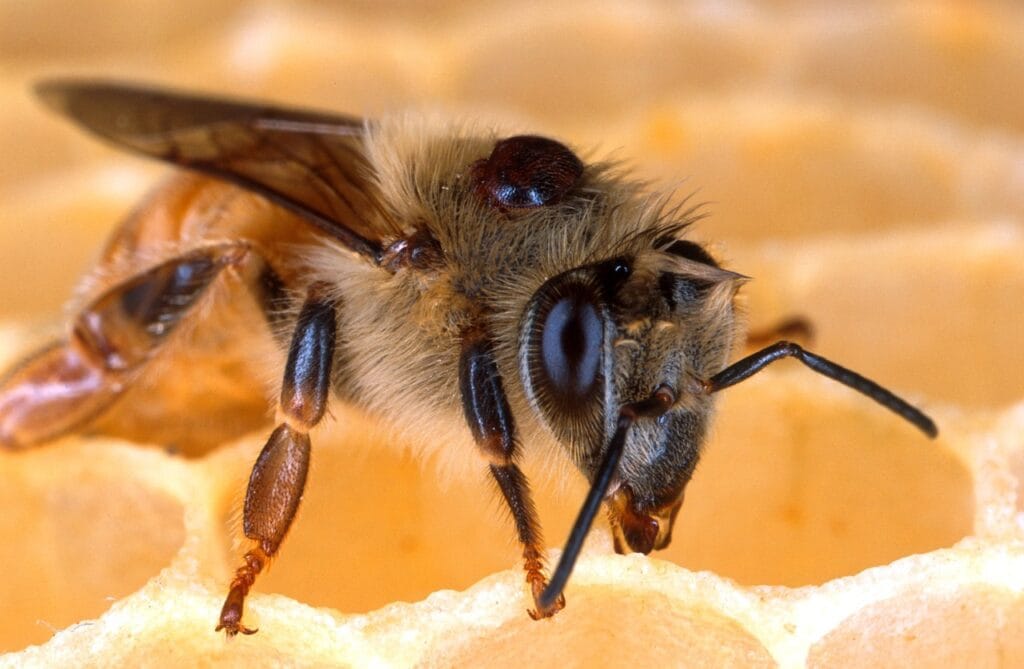Successful beekeeping requires careful attention to seasonal management tasks that align with the natural rhythm of bee colonies throughout the year.
Beekeepers must understand that all beekeeping is local, meaning that specific timing and tasks may vary based on climate, geography, and local flowering patterns.
This comprehensive guide outlines the essential duties for each season to maintain healthy, productive hives.
Spring: Building and Preparation (March-May)
Spring represents the busiest and most critical period for both bees and beekeepers.
As colonies emerge from winter dormancy, their rapid population expansion requires intensive management to ensure successful buildup for the coming season.[2][3]
Early Spring Management (March-April)
Colony Assessment and Health Checks
The first warm days above 55°F (13°C) signal the time for initial spring inspections.
Beekeepers must conduct thorough hive examinations to assess winter survival, checking for signs of life, queen presence, and brood patterns.
This critical assessment determines whether colonies are queenright and viable for the coming season.[4][5]
Emergency Feeding and Nutrition
March and April present notorious risks for starvation as winter stores dwindle and natural nectar sources remain scarce.
Beekeepers must monitor honey reserves and provide 1:1 sugar syrup or fondant when necessary.
Emergency feeding can mean the difference between colony survival and death during unpredictable spring weather patterns.[5][6][4]
Equipment Preparation and Hive Maintenance
Spring cleaning involves removing winter protections such as mouse guards, entrance reducers, and winter wraps.
Beekeepers must clean and disinfect equipment, replace old or damaged components, and prepare new frames with foundation for the upcoming season.[7][8]
Varroa Mite Monitoring and Treatment
Early spring mite management is paramount to colony success.
Beekeepers should conduct mite counts and treat preemptively if levels exceed 4%.
Spring treatments are essential because mite populations will surge as bee populations grow, and delaying treatment until fall may be too late.[9][10][4]
Late Spring Tasks (April-May)
Swarm Prevention and Management
As colonies rapidly expand, swarm prevention becomes critical.
Beekeepers must inspect weekly for queen cells, provide adequate space through supering, and consider splitting strong colonies.
Adding honey supers when frames are 75-80% full prevents overcrowding and reduces swarming impulses.[11][12][6][2]
Queen Assessment and Replacement
Late spring is optimal for evaluating queen performance and requeening if necessary.
Beekeepers should assess egg-laying patterns, brood quality, and overall queen productivity to ensure strong leadership for the coming season.[12][2]
Summer: Production and Vigilance (June-August)
Summer transforms the apiary into a production powerhouse where colonies reach peak population and honey accumulation occurs.
However, this period also presents unique challenges requiring careful monitoring and management.[13][11]
Early Summer Activities (June-July)
Hive Inspections and Space Management
Summer requires regular inspections every 7-10 days to monitor colony health, detect swarming preparations, and ensure adequate space.
Beekeepers must add supers as needed when existing ones are 80% full, allowing bees to continue their productive work.[14][13][11]
Honey Harvesting
Mid to late summer marks the prime honey harvest period.
Beekeepers should harvest frames that are at least 80% capped, ensuring proper moisture content and quality.
However, sufficient honey must be left for the bees’ winter survival needs.[13][11]
Pest and Disease Management
Summer’s warm temperatures create ideal conditions for pest proliferation.
Varroa mites represent the greatest threat during this period.
Beekeepers must conduct monthly mite counts and treat if levels exceed 2%.
Small hive beetles, wax moths, and wasps also require vigilant monitoring and management.[15][11][13]
Late Summer Preparation (August)
Winter Bee Production
Late summer marks the critical transition period when colonies begin rearing winter bees. These long-lived bees will carry the colony through winter, making late summer health management essential for winter survival. Beekeepers must ensure queens continue productive laying to generate adequate winter bee populations.[16][10]
Mite Treatment and Health Assessment
August represents the final opportunity for effective mite treatments before winter.
Mite populations peak as bee populations begin declining, creating unfavorable ratios that can devastate colonies.
Beekeepers must treat decisively using appropriate miticides based on temperature and colony conditions.[10]
Fall: Consolidation and Winterization (September-November)
Fall management focuses on consolidating resources and preparing colonies for winter survival.
The quality of fall preparation directly determines winter success rates.[17][18]
Early Fall Tasks (September-October)
Colony Strength Assessment
Beekeepers must evaluate colony populations and combine weak hives with stronger ones using the newspaper method.
Weak colonies cannot generate sufficient heat for winter survival and should be consolidated rather than left to perish independently.[18]
Food Store Evaluation and Supplementation
Colonies require 60-90 pounds of honey for northern climates or 30-40 pounds for warmer regions.
Beekeepers must assess stores and provide 2:1 sugar syrup supplementation if reserves are insufficient.
Late feeding ensures colonies enter winter with adequate nutrition.[19][18]
Hive Configuration
Fall requires downsizing hive space to match reduced populations.
Beekeepers should remove empty supers, queen excluders, and excess equipment to create manageable spaces that colonies can effectively defend and heat.[20][18]
Late Fall Winterization (October-November)
Pest Management and Protection
Installing mouse guards, hardware cloth, and entrance reducers protects colonies from winter intruders.
Mice, shrews, and other small mammals seek warm shelter and can devastate colonies if allowed access.[17][20]
Ventilation and Moisture Control
Proper ventilation prevents deadly moisture accumulation while maintaining colony warmth.
Beekeepers must balance air exchange with heat retention, often using moisture quilts or ventilated inner covers.[20][18]
Winter: Monitoring and Maintenance (December-February)
Winter requires minimal intervention but constant vigilance. Colonies cluster to maintain warmth while beekeepers focus on equipment maintenance and planning.[21][22]
Colony Monitoring
External Observations
Weekly visual checks ensure colonies remain viable without disturbing the cluster.
Beekeepers should clear entrances of snow and debris, listen for colony sounds, and observe flight activity on warmer days above 55°F.[23][20]
Emergency Interventions
Despite winter’s generally hands-off approach, emergency feeding may be necessary if colonies approach starvation.
Quick interventions with fondant or sugar boards can save colonies when stores run low.[20]
Preparation Activities
Equipment Maintenance
Winter months provide ideal opportunities for equipment repair, assembly, and planning.
Beekeepers should clean tools, assemble hive bodies, repair damaged equipment, and prepare for the coming season.[22][6]
Education and Planning
Successful beekeepers use winter for continuous learning through books, courses, and beekeeping associations.
Planning next season’s management strategies, equipment needs, and colony expansion helps ensure preparedness for spring’s intensive requirements.[22][23]
Year-Round Considerations
Record Keeping
Maintaining detailed hive records throughout all seasons enables informed decision-making and tracks colony performance patterns.
Documentation of inspections, treatments, feeding, and observations creates valuable historical data for future management decisions.[24][20]
Integrated Pest Management
Successful beekeeping requires proactive pest management throughout the year rather than reactive treatments.
Monitoring Varroa mite levels, rotating treatments, and maintaining colony strength provides the foundation for healthy apiaries.[9][10]
Local Adaptation
Beekeepers must adapt seasonal schedules to local conditions rather than rigidly following calendar dates.
Weather patterns, flowering schedules, and regional pest pressures vary significantly, requiring flexible management approaches based on actual conditions rather than predetermined timelines.[1][23]
The seasonal management of beehives demands dedication, observation skills, and adaptability.
By understanding these fundamental seasonal duties and adapting them to local conditions, beekeepers can maintain healthy, productive colonies that thrive throughout the year’s natural cycles.
⁂
- https://idtools.org/thebeemd/index.cfm?pageID=3094
- https://backyardbeekeeping.iamcountryside.com/beekeeping-101/seasonal-beekeeping-calendar-zm0z24mazols/
- https://www.beekeepingfornewbies.com/spring-beehive-management-12-main-tasks/
- https://www.beekeepingmadesimple.com/blog/beekeeping-seasonal-guide
- https://galenafarms.com/blogs/maintaining-a-hive/spring-bees
- https://ebka.org/how-ebka-can-help/beekeeping-tasks-by-month/
- https://www.numberanalytics.com/blog/seasonal-beekeeping-tasks-guide
- https://www.mannlakeltd.com/blog/spring-beekeeping-preparing-your-hives-for-a-productive-season-/
- https://nodglobal.com/seasonal-beekeeping-checklists-spring-and-summer/
- https://cals.cornell.edu/pollinator-network/beekeeping/overwintering
- https://www.honeytruck.com/blogs/bee-blog/summer-beekeeping-duties
- https://www.honeytruck.com/blogs/bee-blog/key-spring-beekeeping-tasks
- https://blythewoodbeecompany.com/blogs/news/summer-beekeeping
- https://www.mannlakeltd.com/blog/your-summer-beekeeping-todo-list/
- https://www.thekeepershive.com/pages/overview-of-seasonal-management-tasks
- https://duckriverhoney.com/blog/summer-hive-management/
- https://www.hobbyfarms.com/fall-maintenance-winter-preparation-bees-hives/
- https://blythewoodbeecompany.com/blogs/news/preparing-your-hives-for-the-fall-10-essential-autumn-beekeeping-tips
- https://www.dadant.com/learn/october-beekeeping-tips/
- https://www.honeybeesuite.com/the-ultimate-guide-to-overwintering-success/
- https://www.mannlakeltd.com/blog/how-to-care-for-a-beehive-in-the-winter/
- https://www.montana.edu/extension/bigskybees/YearintheHive.html
- https://extension.usu.edu/beekeeping/learn/calendar
- https://www.beekeepingfornewbies.com/managing-beehives-a-beginners-guide/



